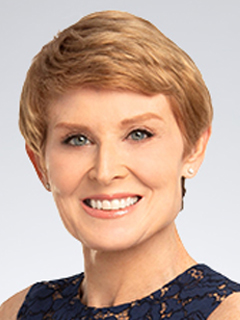
Economic Compass
Birds of a feather no longer flock together
The Fed splits over timing & size of rate cuts
September 10, 2025
A year ago, employment appeared to falter, inflation was cooling and the bond market rallied as the Federal Reserve primed the pump for its first rate cut since March 2020. The Fed made the decision to cut short-term rates by one-half percent to nail an elusive soft landing, or derail inflation without triggering a recession at its September 2024 meeting.
The decision was not unanimous. Governor Michelle Bowman dissented in favor of a less aggressive quarter point cut. The Fed cut an additional quarter point in October and December. The last rate cut was debatable. Cleveland Fed President Beth Hammack dissented, fearing the deceleration in inflation was stalling.
That proved prescient. Inflation picked up in 2025 even as the labor market cooled. Treasury bond yields moved higher as investors sought compensation for rising inflation. The dollar depreciated.
Now the Fed is again poised to cut rates, although not with as much conviction as it did a year ago. Fed Chairman Jay Powell made the distinction clear with his keynote speech at the Jackson Hole Symposium in late August. “The shifting in the balance of risks may [emphasis added] warrant adjusting our policy stance.”
Have weak employment reports changed that calculus? Not as much as some would like. The Fed has a dual mandate to foster price stability and full employment. It is not clear whether the slowdown in employment alone will curb the tariff-induced boost to inflation, while the embers of the pandemic inflation are still smoldering.
The Fed’s March forecast called for a mild bout of stagflation - a toxic mix of escalating prices and rising unemployment - in 2025. That forecast became more pronounced in June. The next forecast is due at the September meeting. It is harder to live in even a mild bout of stagflation in real time.
The result spurred debate within the Fed. Doves see the jump in inflation due to tariffs as transitory and are pushing for a larger rate cut at the September meeting. They worry that the weakness in employment alone will do more than derail inflation.
Hawks fear that a bout of inflation so close to the pandemic inflation could become more entrenched. They prefer the Fed to stay on the sidelines to prevent a repeat of the mistakes of other central banks, including those in the Fed itself in the 1970s. The rest of the Fed’s leadership fall somewhere between those extremes.
This edition of Economic Compass takes a closer look at why the outlook for inflation is so uncertain, despite a chill in the labor market. Special attention is paid to “data dependence,” or the Fed’s decision rule for monetary policy. A high level of uncertainty has clouded the Fed’s outlook for the economy, which has left it relying on shifts in the data to make policy decisions. That leaves the Fed more reactive than proactive in its decisions, as the data are lagged.
We expect the Fed to cut three times by year-end, with dissent potentially in both directions. Such dissonance within the ranks of the Fed is not unprecedented. The last time it happened was in 2019, when fears of recession spiked in the wake of the trade war with China. That is not reassuring.
Inflation dynamics
Inflation decelerated pretty much without pause from the1980s to the onset of the pandemic. It was not in the forefront of our minds for much of our collective lives.
Two-thirds of the labor force were born in 1982 or later, which means that they had no experience with inflation until after the pandemic. Shortages due to supply chain problems pushed prices up, while stimulus helped consumers absorb price hikes. The surge was global.
The Fed was not alone in being late to acknowledge or deal with post-pandemic inflation. Most central banks across the developed economies had grown accustomed to the slow moving, disinflationary environment of the 2010s. They were more focused on catching up with employment than derailing inflation.
That does not give it a pass. Central banks are designed to worry about inflation more than employment, even when they have a dual mandate like the Fed’s. That is because inflation is one of the most corrosive economic phenomena.
The blistering bout of inflation post-pandemic was so painful that most Americans believed the economy was in a recession, even as job gains remained robust and unemployment fell. That is because prices moved up faster than wages and eroded the purchasing power workers gained via higher wages.
Full employment cannot be achieved without fully derailing inflation. History is littered with examples of central banks cutting rates too soon to stimulate their economy in the wake of a bout of inflation, only to have their efforts backfire. Inflation picked up, which eroded purchasing power and stoked a more pernicious bout of inflation or worse, stagflation.
Argentina, Hungary and Türkiye are all examples of just how damaging such policies can be. Argentina is emerging from two years of austerity and recession. Inflation slowed from a mind-boggling peak of 292.2% in April 2024 to 36.6% in July. That is the slowest since the pandemic, but still stunningly high.
We have already seen goods prices move up in response to tariffs. The Fed and many in the economics community were hoping those increases would be muted by a slowdown in service sector inflation. That turned around in July as wealthier households helped to carry discretionary spending. It needs to be watched closely as it could offset the pushback on prices by low- and middle-income households.
Tariffs & inflation
Tariffs behave much like a sales tax. They boost tax revenues on imports coming into the country. The cost is borne initially by the firms importing the goods into the US; a portion of those costs have historically been passed onto consumers. The goal is similar to a sin tax – taxes on alcohol and cigarettes. Tariffs raise the cost of imports to discourage purchases.
Research by the Boston Fed estimates that each 10% increase in tariffs adds about 1% to producer prices. That translated to a 0.3% increase in the consumer price index during the 2018-19 trade war. The problem is that tariffs are significantly higher than they were back then. (See Chart 1.)
Exporters may lower their prices to keep market share in the face of tariffs. Our own research suggests that has not happened yet.
In theory, tariffs should show up as a one-time bump in the level of prices. That is why doves at the Fed prefer to “look through” the tariff effects on prices and cut rates more aggressively now.
Powell was careful to point out that a “one-time” increase in prices does not equate to “all at once.” The sequencing of tariffs and uncertainty over future tariffs are expected to prolong the period when prices are elevated.
Those shifts are in addition to service sector price hikes due to tariffs. Costs for dental services surged in July due to the rise in the costs of materials and equipment; much is imported. We should see a similar spillover for insurance costs.
Everything from tariffs to curbs on immigration are boosting the costs of repairs and rebuilding. Wages have accelerated in construction, an industry that relies heavily on immigrant labor. That is despite a drop in construction employment and before we feel the full effect on insurance premiums due to last year’s hurricanes and this year’s fires.
Chart 1: Tariffs taper off
Effective tariff rate, percent
Lingering inflation
Chart 2 shows the forecast for the Fed’s preferred inflation gauge, the core personal consumption expenditure (PCE) index. The core measure excludes the volatile food and energy components; core is the best predictor of future inflation.
The core PCE is expected to cross 3% by year-end and hold close to 3.0% for much of 2026. That is nothing like the searing inflation post-pandemic, but still too hot.
Hawks worry the proximity to the pandemic inflation makes fertile ground for a more lingering bout of inflation. Consumers and firms now expect inflation to rise, which could become a self-fulfilling prophecy.
The ultra-low inflation of the 2010s conditioned firms and consumers that price hikes were not acceptable. Conversely, periods of prolonged inflation become normalized, making it easier to raise prices.
Firms that never raised prices pre-pandemic are now familiar with more frequent price hikes. They have restructured contracts to enable them to rapidly adjust and pass along higher costs. Consumer surveys reveal they have come to expect higher inflation in the future.
We have not seen anything like that since the stagflation of the 1970s. The sequencing of tariffs only fuels that unmooring of inflation expectations, as it will create several waves of inflation. That feeds into fears that inflation will persist, which could extend and amplify the inflation due to tariffs into 2027.
Chart 2: Inflation accelerates into year-end
Core PCE, year-over-year percent change
Are the tariffs illegal?
A coalition of 12 states – red and blue – and a conservative small business group sued the administration for its use of emergency powers to levy tariffs. An appellate court ruled at the end of August that most of the tariffs issued by the administration were unlawful. The exceptions were tariffs on steel, aluminum and copper.
The appeals court set a deadline of October 14, after which the tariffs will no longer be enforceable. If the Supreme Court sides with the lower courts, which is not a slam dunk, then the Treasury could be forced to refund tariffs already paid, with interest.
Wall Street is so convinced that the ruling will stick that a cottage industry is emerging to deal with the fallout. Banks are offering to refund a part of the tariffs that companies paid for the right to collect the whole amount, plus interest later.
The administration has other levers it can pull to quickly reinstate tariffs ruled illegal. Those span sections 122, 301 and 338 tariffs and will add to the ten section 232 investigations currently underway. That could keep tariffs in effect but not stop the need to reimburse firms or their surrogates on Wall Street for tariffs paid.
The moral of the story: even if the tariffs are deemed illegal, they will be rapidly reinstated. Refunds will take time, which is fine for Wall Street but not as good a deal for those looking for relief on tariffs. The continuation of tariffs means the upward pressure on prices will persist.
Risks: Inflation is forecast to remain above target for the next two years, barring a recession. The risk is that it could pick up again in 2027 due to an unmooring of inflation expectations.
Labor market dynamics
Another way tariffs could become entrenched is via a tight labor market. If workers have enough leverage, they can demand that firms compensate them for the acceleration in inflation. That can trigger what is known as a wage-price spiral, which was another characteristic of the 1970s stagflation.
The overall unemployment rate is still near an historic low, but that is not the whole story. The stress measure of unemployment, which includes marginalized workers, jumped to 8.1% in August. That is its highest rate since October 2021.
The ranks of the long-term unemployed (27 weeks or longer) ballooned to the highest level since December 2021. Those workers as a share of the civilian labor force have increased in recent months. Historically, that has only occurred after we were in a recession.
Those shifts have lowered churn in the labor market, which limits the need to compete for workers. Those who have a job are essentially frozen in place, while those without are frozen out of the labor market.
That has slowed but not fully derailed wage gains. The employment cost index, which was developed to better gauge the pressure that wages were exerting on costs, has cooled from a peak of 5.2% in the second quarter of 2022 to 3.6% in the second quarter of 2025.
That is still above the 3.2% pace of 2019. Wages will need to cool or productivity will have to pick up for inflation to get back to the Fed’s 2% target.
The bulk of the layoffs and spillover effects due to government cutbacks have yet to hit. Some 151,000 federal workers who took buyouts will fall off the payrolls with the start of the new fiscal year, October 1.
Those losses could be partially offset by the ramp-up in hiring by the Department of Homeland Security. They reported getting more than 100,000 applications in August alone.
The key is collateral damage to individual ecosystems. The Atlanta Fed estimated that we could lose up to 1.2 million more jobs as federal job losses and cuts ripple through local communities. The federal government, universities and healthcare providers are often the largest employers in those zip codes.
Curbs on immigration are another factor to watch. They are reducing the supply of workers, which is currently helping hold down unemployment. We cannot rule out pockets of shortages where those workers dominate.
Farmers and builders are on the front lines of the shifts, along with the hospitality and care economy – child and elder care. The prices for child and elder care are rising at more than double the pace of overall inflation.
Tariffs & the labor market
Tariffs affect employment via a multitude of ways:
- They reduce competition for protected industries and fuel job gains in those sectors.
- They boost input costs, which squeeze profit margins and reduce employment in industries paying tariffs.
- They force producers to rethink supply chains, although research on the 2018-19 trade war is not encouraging. Most suppliers moved from China to other emerging markets in Asia, not the US.
- Retaliation dampens exports – the backlash to US products in Canada is pronounced, even though the country dropped its retaliatory tariffs.
- Higher prices erode demand for both consumers and firms.
- They boost uncertainty as our trade policy continues to evolve, which can trigger hiring freezes.
Research by the Fed’s Board of Governors estimated that the 2018-19 trade war cost the US 230,000 more jobs than it generated. Research at the Minneapolis Fed found that higher input costs and retaliation were the largest drivers of those employment losses. The net job losses due to tariffs could top 2 million.
Curbs on competition tend to fuel inefficiencies, which undermines productivity growth. Tariffs tend to increase the costs of investment goods even more than consumer goods, which further undermines investment and productivity growth down the road.
The largest offset in the near term is the 100% bonus depreciation, which was part of the One Big Beautiful Bill Act. That enables firms to fully expense the cost of major equipment and some structures, which is mitigating tariff costs.
New orders for some equipment have begun to pick up in response to that change, although some of the increase reflects more tariff front-running. Computers top that list. Tariffs on semiconductors and their derivatives (computers) are due out later this year.
Risks: The bulk of the tariff-induced dampening of employment is still ahead of us. That may not end labor shortages, as foreign-born workers often fill jobs that native-born will not.
The Fed’s decision rule
Downside to “data dependence”
“As is often the case, we are navigating by the stars under cloudy skies.”
- Chairman Jay Powell, August 25, 2023.
Ideally, the Fed would adjust its forecasts and pivot on policy with enough lead time to change the course of the economy to avoid the worst outcomes. That is more difficult during periods of heightened uncertainty and low visibility into how the economy will evolve.
That is where we are today and have been for much of the post-pandemic era, although “data dependence” became part of the Fed’s lexicon in the late 2010s. It was designed to improve the Fed’s decision making when forecasts become more uncertain.
I cannot think of a more uncertain period than we have seen this year. Measures of uncertainty eclipsed the surge we saw at the onset of the pandemic at home and abroad. Shifts in trade policy drove those increases. It is still in the stratosphere. (See Chart 3.)
We are unlikely to return to anything resembling normal for a while, given the evolving tariff landscape. The president threatened to raise tariffs on the EU again over the weekend after a major fine was levied against a US tech behemoth.
That is in addition to the renegotiation of the US-Mexico-Canada Agreement and the need to adjust tariffs to boost the competitiveness of domestic vehicle producers. It is currently cheaper to import a vehicle under the deals with the EU, Japan, South Korea and the UK than to produce in the US. That is contrary to the stated objective.
The pros are that it enables the Fed to be nimble and shift course on policy based on economic data. It builds credibility as the Fed is making decisions on evidence-based data instead of theoretical models.
The cons are that the data are lagged and subject to revision. Government statistical agencies rely heavily upon history to make estimates for gaps in the data to release it in a timely manner.
That history works against it at turning points, as we saw in July; job gains were revised significantly lower once information from more establishments was available. Again, that leaves the Fed more reactive than proactive in its policy decisions.
Chart 3: Uncertainty still in the stratosphere
Trade policy uncertainty index, (100=1% share of articles)
A rate cutting cycle?
Chart 4 shows the forecast for the fed funds rate. September is expected to mark the start of a tentative rate-cutting cycle. If the Fed cuts short-term rates by a quarter point in September, we could see dissents in two opposite directions.
Dissents could dominate until we gain more visibility into inflation. A change in leadership at the Fed is likely to bias it toward stimulating in the back half of 2026.
We will not know if that is an overshoot or not enough until we get into 2027. Hence, the slow descent on the tariff-induced inflation.
The EU and Canada are in talks with Latin American countries to join Mercosur – a free trade zone in South America. That would cover more than a quarter of the world’s population and provide a platform to export tariff-free. Mexico has a record-breaking 16 free trade agreements with 50 countries.
Those shifts, coupled with a higher level of certainty on where tariffs will land, should pave the way for a stronger 2026. The risk is that inflation does not come down as much as hoped.
Risks: Financial conditions have eased since the start of the year, with credit spreads narrowing and equity markets continuing to hit record highs. The risk is that we see further cuts to ease financial conditions and that the Fed overstimulates.
Chart 4: Fed begins cutting cycle
Federal funds rate, upper bound
A floor for Treasuries
Treasury bonds have rallied in anticipation of rate cuts but remain well above the levels hit a year ago. Inflation will get hotter before it cools, while concerns of overstimulating by the Fed rise. Foreign central banks are already holding more gold than Treasuries for the first time since the 1990s.
Gold purchases are seen as a better hedge against inflation than US Treasuries because inflation fears are focused on the US. Those shifts are creating a floor under long-term Treasury yields.
We should not expect a return to the ultra-low rates of the 2010s, barring a major financial crisis, which cannot be ruled out. Asset prices are getting frothy. Inequality fuels asset bubbles, as more affluent households can afford to take larger risks with their investments than low- and middle-income households.
Risks: Treasuries could move higher if the government fails to get a continuing resolution or fiscal year 2026 budget prior to October 1. A government shutdown cannot be ruled out, which could result in additional downgrades to our credit rating.
Bottom Line

The Fed is poised to cut interest rates in September but with even less certitude than a year ago, despite a weaker labor market. That is because the war on inflation has not yet been won, more than four years after inflation first accelerated. That has spurred healthy debate within the Fed about the course of policy from here, which has spilled out into the open.
The bond market has its own demons. Fears of inflation have returned. That suggests that a floor could form under long-term yields. Bond yields could even move higher if the Fed fails to slay any tariff-induced inflation.
Prospects for 2026 are better, aided by lower short-term rates and expansions to tax cuts. May the bridge from here to there be short. Be kind; pay it forward.
Interest rate and tax cuts boost growth
Real GDP is expected to grow 1.7% in the third quarter, slightly above the 1.4% average of the first half of the year. Consumer spending and housing market activity are expected to remain subdued while business investment and inventory accumulation drive overall gains. The 100% bonus depreciation should offset some of the costs associated with higher tariffs as the boom in AI investment continues. The trade deficit is expected to widen modestly as the front-running on imports picked up again in July ahead of the August tariff announcements.
Government spending is poised to rise slightly as the fiscal 2025 budget was finally passed. Gains at the federal level offset weakness at the state and local levels, which had been a driver of government spending earlier in the year. Congress still needs to pass a budget for fiscal 2026 or we could face a government shutdown October 1. Congress could temporarily punt on a fiscal 2026 budget with yet another continuing resolution, which would hold much of discretionary spending constant.
The largest upward pressure on government spending will come from aging demographics. Younger baby boomers have begun to tap their Social Security benefits early for fear of losing them later. Medicare is also rising, while cuts to Medicaid will hit hardest after the 2026 midterms.
Prospects for the fourth quarter are not quite as good, with real GDP forecast to rise 1.6%. The tailwind of lower rates and accelerated bonus depreciation are partially offset by the need to liquidate the inventories amassed in anticipation of tariffs. AI investment is expected to buoy spending on intellectual property; investment in new structures is expected to remain weak. The trade deficit is expected to improve slightly.
The Fed starts to cut. The Federal Reserve is expected to start cutting rates to offset weakness in the labor market. Much of that is contingent upon inflation moving up only modestly. Changes in Fed leadership in the second half of the year are expected to open the door to additional monetary easing. However, it remains unclear how the Treasury bond market will respond to those shifts. Concerns about inflation from foreign buyers of our debt moved up this year as tariffs were rolled out.
Economic Forecast — September 2025
Dive into our thinking:
Explore more

Dog days of summer: Tariffs start to bite
How tariffs act on the economy.

KPMG Economics
A source for unbiased economic intelligence to help improve strategic decision-making.

Summer heatwave continues
The super core CPI jumped 0.5%.
Subscribe to insights from KPMG Economics
KPMG Economics distributes a wide selection of insight and analysis to help businesses make informed decisions.
Meet our team
